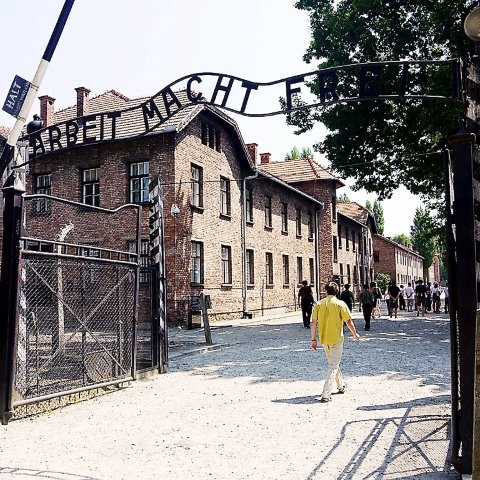click to dowload our latest edition
CLICK HERE TO SUBSCRIBE TO OUR NEWSLETTER


Published
6 years agoon
By
adminROBYN SASSEN
Documenting the complex of concentration camps collectively known as Auschwitz from the time of its liberation, this French film with subtitles presents complex, unresolvable questions.
“The atrocities only happened over a four-year period,” argues one Polish citizen, attempting to justify the existence of her home, which, complete with ducks and young children in the garden, is built on the land. “We have lived here for over 50 years.”
It isn’t only about domestic roots, however. Soon after the camp’s liberation, on January 27, 1945, pillagers moved in. They were digging for gold, prompted by an anti-Semitic belief that if there were Jews here, gold would be too. It was a surreal time, explains the museum’s director, Piotr Cywinski, as survivors were still living there. In 1947, a territorial confrontation between former prisoners and gold diggers led to Poland declaring it a state museum.
But this did not solve the problem. Rather, it represented a quest for Polish brownie points. The idea of a museum supported Poland’s post-war regeneration. It pitched Auschwitz as a place of pilgrimage, to generate Polish tourist income.
Oswiecim, where Auschwitz is located, then boomed economically due to a quest for normality on the part of its citizens, explains Cywinski, adding that the town was established in the 13th century. Before the war, its Jews numbered 7 500 souls, who nicknamed it “Ushpizim” (“guests”).
Furthermore, the museum carried an unspoken agenda. In its promotional material, until the 1970s, the word “Jew” was absent. Does this “airbrushing out” the Jewish reality of Auschwitz reflect the psychology of trauma? Either way, the enormity and specificity of atrocities committed on this soil was erased.
This was to change in 1979, when the then Pope, John Paul II – who was Polish-born and a former bishop of Krakow – came to Auschwitz on an unprecedented formal visit. He said: “Never forget your spiritual freedom” and spoke about Edith Stein, a Jewish-born Carmelite nun who was murdered in Auschwitz.
Stein’s story was touted in Auschwitz-related material, leading to a Carmelite convent being built on the grounds. Was this an attempt to “Christianise” Auschwitz? Discord was sewn, necessitating a papal intervention in 1989. He said Auschwitz must be returned to its dead and shouldn’t be exploited for political or religious reasons.
As the 1980s drew to a close, Holocaust denialism raised its ugly head. Under Robert Faurisson, pseudo-scientific reports were published, aiming to wipe the slate clean of Auschwitz veracity. The March of the Living was then initiated to counter Faurisson and his followers.
As an educational tool, the march took on international momentum, embracing the quest to find the remains of Birkenau I, where the gas chambers had been located. It was a more difficult task than anticipated; the team eventually located Shlomo Dragon, a Sonderkommando Jew who was tasked to aid the Nazis in the disposing of Jewish remains, and who remembered how to get there.
What they discovered took things to a different level of horror: the gas chamber, where millions of Jews were killed, was now a domestic house. Richard Prasquier, president of Yad Vashem, bought it and made it a part of the Auschwitz museum. The house was demolished; a memorial of three columns was erected in its stead.
Auschwitz’s status shifted over the years. In 1979, it was declared a UNESCO world heritage site, but the area’s 50 000-strong community complained about the number of tourists and the restrictions this status represented with regard to domestic and commercial growth.
In 1999, protests by civilians of Brzenzinka – the village where Birkenau was located – came to a head. They wanted a shopping mall.
And the uncertainty and inflammation continues – UNESCO attempted to re-establish its zone of silence status again in 2010, but failed.
Today, it remains one of the world’s most visited museums. Father Patrick Desbois, founder of Yahad In-Unum, an organisation dedicated to the discovery of unmarked mass graves in Europe, says the popularity doesn’t serve it. You need time to reflect on the atrocity when you’re there, he says. Because it is so popular, the curatorial decision to limit visitors’ time has been forced.
He also says the museum “sanctifies the machinery of death, making it very difficult to focus on the victim”.
Auschwitz still bears no plaque with its victims’ names, and the arguments rage on: Is it just history? Should it be about Jewish identity? Now, more than 70 years after its liberation, it’s uncertain as to what the next generation will do with Auschwitz.
